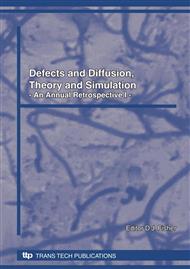[1]
C.W. Cheng, G.Y. Xu, H.Q. Zhang, H. Wang, J.M. Cao, H.M. Ji: Mater. Chem. Phys. Vol. 97 (2006), 448.
Google Scholar
[2]
M. Tanaka: J. Lumin. Vol. 100 (2002), p.163.
Google Scholar
[3]
M. Morita, M. Baba, H. Fujii, D. Rau, M. Yoshita, H. Akiyama, M. Herren: J. Lumin. Vol. 94-95 (2001), p.191.
Google Scholar
[4]
R.J. Bandaranayake, J.Y. Lin, H.X. Jiang, C.M. Sorensen: J. Magn. Magn. Mater. Vol. 169 (1997), p.289.
Google Scholar
[5]
D. Rodic, V. Spasojevic, A. Bajorek, P. Onnerud: J. Magn. Magn. Mater. Vol. 152 (1996), p.159.
Google Scholar
[6]
V. Spasojevic, D. Rodic, A. Bajorek, A. Szytula: J. Magn. Magn. Mater. Vol. 128 (1993), p.375.
Google Scholar
[7]
M. Nawrocki, Y.G. Rubo, J.P. Lascaray, D. Coquillat: Phys. Rev. B Vol. 52 (1995), p. R2241.
Google Scholar
[8]
P.B. Dorain: Phys. Rev. Vol. 112 (1958), p.10.
Google Scholar
[9]
H.N. Dong, X.X. Wu, S.Y. Wu, W.C. Zheng: Acta Phys. Sin. Vol. 51 (2002), p.616.
Google Scholar
[10]
S.Y. Wu, W.Z. Yan, X.Y. Gao: Spectrochim. Acta A Vol. 60 (2004), p.701.
Google Scholar
[11]
J.S. Griffith: The Theory of Transition-Metal Ions (Cambridge University Press, London 1964).
Google Scholar
[12]
L.H. Wei, S.Y. Wu, Z.H. Zhang, H. Wang, X.F. Wang: Mod. Phys. Lett. B Vol. 22 (2008), p.1739.
Google Scholar
[13]
V. Bindilatti, A.N. Anisimov, N.F. Oliveira, Jr.Y. Shapira, M. Goiran, F. Yang, S. Isber, M. Averous, M. Demianiuk: Phys. Rev. B Vol. 50 (1994), p.16464.
DOI: 10.1103/physrevb.50.16464
Google Scholar
[14]
D.J. Newman, B. Ng: Rep. Prog. Phys. Vol. 52 (1989), p.699.
Google Scholar
[15]
A. Edgar: J. Phys. C Vol. 9 (1976), p.4303.
Google Scholar
[16]
Z.Y. Yang: J. Phys.: Condens. Matter Vol. 12 (2000), p.4091.
Google Scholar
[17]
N.J. Werring, A. Vecht, J. W. Fletcher: Brit. J. Appl. Phys. (J. Phys. D) Vol. 2 (1969), p.509.
Google Scholar
[18]
E. Clementi, D.L. Raimondi: J. Chem. Phys. Vol. 38 (1963), p.2686.
Google Scholar
[19]
E. Clementi, D.L. Raimondi, W.P. Reinhardt: J. Chem. Phys. Vol. 47 (1967), p.1300.
Google Scholar
[20]
E.K. Hodgson, I. Fridovich: Biochem. Biophys. Res. Commun. Vol. 54 (1973), p.270.
Google Scholar
[21]
A. Abragam, B. Bleaney: Electron Paramagnetic Resonance of Transition Ions (Oxford University Press, London 1970).
Google Scholar
[22]
B.R. McGarvey: J. Chem. Phys. Vol. 71 (1967), p.51.
Google Scholar
[23]
R.C. Weast: CRC Handbook of Chemistry and Physics (CRC Press, Boca Raton 1989) p. F 187.
Google Scholar
[24]
W.C. Zheng, S.Y. Wu, H.N. Dong, J. Zi: Spectrochim. Acta A Vol. 58 (2002), p.537.
Google Scholar
[25]
Y.I. Kim, K. Page, R. Seshadri: Appl. Phys. Lett. Vol. 90 (2007), p.101904.
Google Scholar
[26]
K. Ogasawara, T. Ishii, F. Oba, I. Tanaka. H. Adachi: Lumin. Mater. Vol. 560 (1999), p.341.
Google Scholar
[27]
N. Gemma: J. Phys. C Vol. 17 (1984), p.2333.
Google Scholar


